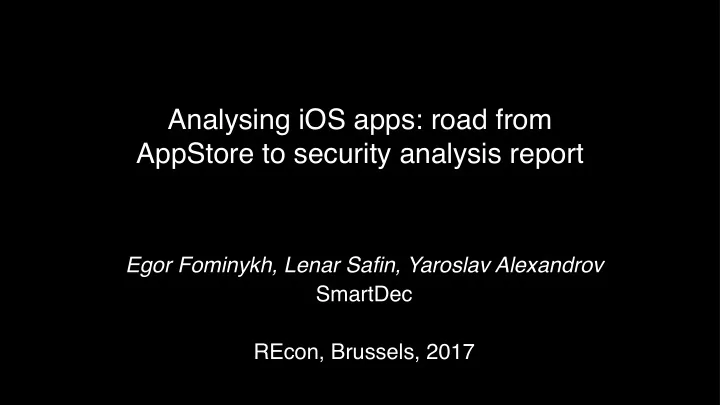

Analysing iOS apps: road from AppStore to security analysis report Egor Fominykh, Lenar Safin, Yaroslav Alexandrov SmartDec REcon, Brussels, 2017
What we do at SmartDec • Decompilation, deobfuscation – x86/x64 – ARM/AArch64 – JVM, Android – Custom (VMs, less known archs, …) • Code analysis (sources and binaries) – Manual static analysis – Pentesting – Analysis tools development
iTunes link https://itunes.apple.com/us/app/balloonist-travellers-world/id1070769999?mt=8 Pseudocode Security report
Plan • Get an application binary • Translate application binary into some IR • Analyse IR for security flaws • Translate IR into human-readable pseudocode
1: Getting binary
A problem Applications are encrypted. Decryption: 1. Launch an app on an iOS device. 2. iOS decrypts it and loads it to RAM. 3. Dump decrypted binary from RAM. Jailbroken iOS device is needed.
Jailbreak • SSH • Bash • Cydia Substrate (call/hook any method) • Clutch
Approach • Figure out chain of method calls / GUI decisions to initiate the download • Figure out how to make needed GUI decisions programmatically, using Cydia Substrate
Main applications • Springboard.app (GUI) • AppStore.app
Process 1. Unlock device — SpringBoard 2. Uninstall all apps — SpringBoard 3. Open iTunes page — SpringBoard 4. Press GET button — AppStore 5. Sign in (detect sign in alert, fill login/password, press ok) — SpringBoard 6. Wait OPEN button — AppStore 7. Decrypt — Clutch
2: Translation into IR
iOS application recovery challenges • Lots of things to recover – Functions – Program CFG – Call site arguments and function signatures – Objective-C/Swift interfaces (even C++) – Data flow of the program • AArch64 – ARM32 is not supported anymore
Why LLVM? • Nice and useful • Bunch of algorithms – Alias Analysis – Dominators – Loops – Transformations and optimizations • Pass Manager • Ok for C-family apps
Ideas • Fast automatic translation into LLVM • Functions and function calls recovery • CFG reconstruction • Types and variables recovery • Objective-C/Swift3 support
Architecture
Image parsing • Unpacking Fat (Universal) binaries • Mach-O • Symbols • Function starts • Objective-C runtime (__objc_*) • Swift virtual tables
CFG reconstruction • Entry point • Function starts • Vtables • Call sites • __TEXT section inspection • Tail calls and trampolines
Trampolines
Tail calls
Interface recovery • Objective-C interface – Classes – Protocols – Method names – Ivars – Demangling • Swift interface – Vtables – Class hierarchy – Demangling
Objective-C runtime
Objective-C runtime
Swift runtime
Variables and types • Memory object reconstruction – Temporary – Variables – Globals – Strings • Types recovery – Interprocedural arguments recovery – Known function signatures – Objective-C signatures – WIP: arrays and structs (we already have done it for x86)
Objective-C function signatures parsing example
LLVM generation • Translation preserving semantics • Simplification – DCE (dead code elimination) – MemProp – ConstProp • CFG region analysis
Example
Example
Example
3, 4: Vulnerabilities detection and results presentation
Pseudocode LLVM to Objective-C/Swift-like pseudocode (more accurate for Objective-C) – Function names, signatures – Statements – Arguments – Types – Call sites – Structural analysis (WIP)
Pseudocode
Analysis • Pattern matching on LLVM (detects most of vulnerabilities) • TBD: deep dataflow analysis (e.g., taint analysis) • LLVM to pseudocode mapping (for results presentation)
Vulnerabilities: data transfer Weak SSL
Vulnerabilities: data transfer No SSL
Vulnerabilities: bad crypto MD5, SHA1, 3DES, etc…
Vulnerabilities: data storage – Pasteboard usage – NSLog – Background mode
Vulnerabilities: reflection
Vulnerabilities: TBD • Unencrypted sensitive data storage in application directory • Cache of network requests • Data validation (SQLi, XSS, path manipulation, …) • Weak jailbreak detection • Authentication (2fa, password complexity, number of attempts)
Statistics: vulnerabilities Vulnerabilities NSLog 6% 7% Deprecated 9% Reflection 40% Weak cipher 9% No SSL Weak SSL 14% Pasteboard 15%
Conclusion • Our toolset can: – Find vulnerabilities in iOS app using only its iTunes link – Present these vulnerabilities on pseudocode • Future work: – Deep analysis (dataflow, etc.) – Less false positives – Objective-C/Swift decompilation
Questions? alexandrov@smartdec.net safin@smartdec.net
Recommend
More recommend